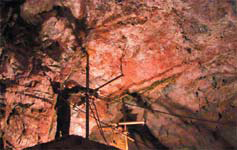

Thursday - January 18, 2007
SLAC Today is
available online at:
http://today.slac.stanford.edu
In this issue:
CDMS Update: Increased Sensitivity for Dark Matter Search
Science Today: ILC's Marx Modulator
In Memoriam: John Jasberg
 |
 |
|
Thursday - January 18, 2007 |
CDMS Update: Increased Sensitivity for Dark Matter Search
Northern Minnesota's Soudan Mine, where, half a mile underground, a team of KIPAC scientists searches for signatures of dark matter.
Deep below the snow and ice of Northern Minnesota, Cryogenic Dark Matter Search (CDMS) detectors are performing splendidly. Shielded from cosmic radiation at the bottom of the Soudan mine, the detectors began searching for evidence of dark matter in 2003. Thanks to the hard work of the CDMS team, a collaboration of 13 universities and national labs across the U.S., the sensitivity of these detectors has increased enormously over the past four months. "We are now surpassing the combined exposure of our previous runs, doubling our expected sensitivity," said Stanford Professor and Co-Spokesperson for CDMS, Blas Cabrera. "This increases our chances of finding a Weakly Interacting Massive Particle," or WIMP. The CDMS detectors, designed by KIPAC researchers at Stanford and collaborators at other institutions, use superconducting sensors to search for lattice vibrations or heat in germanium and silicon crystals: the signature of a WIMP passing through. WIMPS are thought to be the dominant form of matter in the universe. Read more... |
||
|
|
||
 ILC's Marx Modulator
The current design for the International Linear Collider (ILC) requires 576, 10-megawatt klystron tubes to supply microwave power along its 40 km linear accelerator. Each ILC klystron tube needs 120,000 volt, 140-ampere pulses, fired at a rate of five pulses per second. Each pulse delivers a total energy of more than 23 kilojoules—the kinetic energy of a 20 millimeter cannon shell. Conventional modulator designs use a transformer just before the klystron to raise the output voltage up to 100’s of kilovolts. However, the high pulse energy of the ILC klystron would require a truly massive (and expensive) transformer—upwards of 6.5 tons. The ILC Marx Modulator eliminates the need for a massive transformer by using the relatively simple Marx concept: charge a number of capacitors in parallel, and then reconnect them in series to produce a higher voltage. Read more... |
In Memoriam:
|
Events (see all | submit)
Access (see all)
Announcements
|
| | ||
|
|
||
 <%
Response.AddHeader "Last-modified", getArticleDate()
'Response.AddHeader "Last-modified","Mon, 01 Sep 1997 01:03:33 GMT"
'Monday, December 06, 2010
%>
<%
Response.AddHeader "Last-modified", getArticleDate()
'Response.AddHeader "Last-modified","Mon, 01 Sep 1997 01:03:33 GMT"
'Monday, December 06, 2010
%>View online at http://today.slac.stanford.edu/. |
||